¶ Introduction
When flying IFR inside controlled airspace, air traffic controllers either providing a service to an aircraft under their control or to another controller's traffic, have a duty to provide a separation above the minimum standard separation between the subject and other aircraft.
This document presents the IFR separation when an ATS surveillance system is not present (radar) in the provision of area control service and approach control service.
This document is not meant for aerodrome control service.
¶ Definition
¶ Types of separation
There are 2 main types of separation:
- Vertical separation
- Horizontal separation
¶ Vertical separation
Vertical separation is obtained by requiring aircraft to use prescribed altimeter settings procedures to operate at different levels in terms of flight level or altitude.

¶ Horizontal separation
There are two types of horizontal separation:
- Lateral separation
- Longitudinal separation
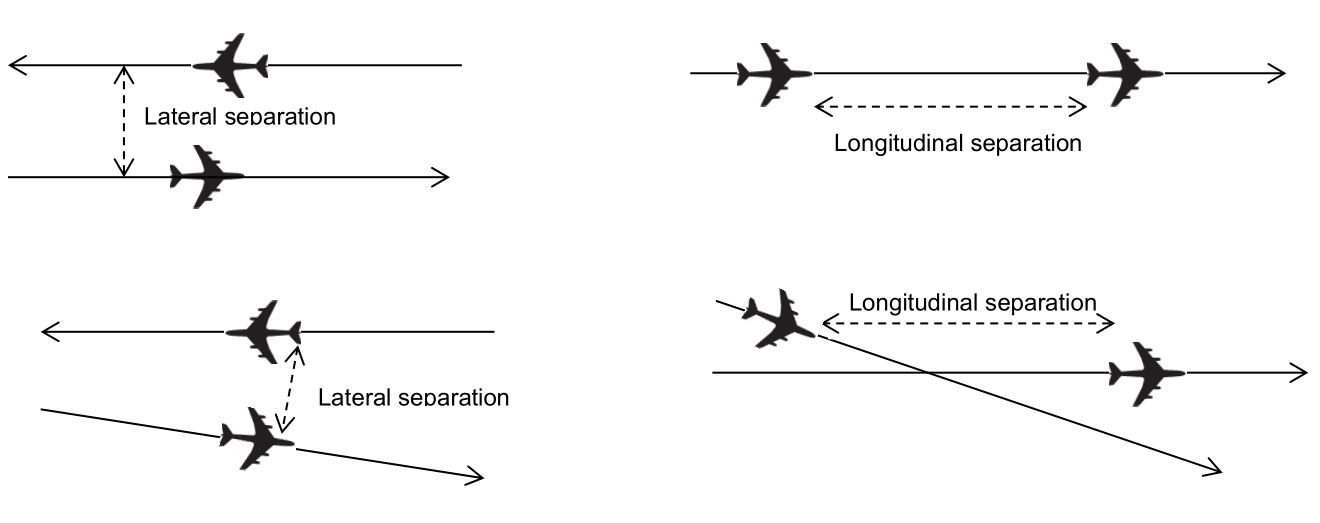
¶ Composite separation
A composite separation is a term which can be used when applying a combination of horizontal separation and vertical separation.
¶ Controlled Airspace
IFR traffic shall be separated:
- Between IFR flights in class A, B, C, D or E airspace
- Between IFR flights and VFR flights in class C, D or E airspace
- Between IFR flights and special VFR flights when prescribed by the national regulations
- Between special VFR flights when prescribed by the national regulations
¶ Rules
An air traffic controller shall avoid the loss of separation at all times by providing adequate instructions or clearances in order to keep separation of all aircraft in his airspace with all other aircraft (in his airspace or not) above the applicable minimum standard separation in the airspace concerned.
No clearance shall be given to execute any manoeuvre that would reduce the spacing between 2 aircraft to less than the separation minimum.
Larger separation than the specified minima should be applied whenever exceptional circumstances such as unlawful interference or navigational difficulties call for extra precaution.
This should be done with due regard to all relevant factors and the air traffic controller shall pay attention to not entering into application of excessive separation logic.
¶ Separation criteria
2 aircraft can be considered separated if a minimum of one type of separation is established.
| Vertical separation | Horizontal separation | Aircraft are separated? |
|---|---|---|
| Below minimum | Below minimum | No |
| Below minimum | At or above minimum | Yes |
| At or above minimum | Below minimum | Yes |
| At or above minimum | At or above minimum | Yes |
¶ Loss of separation
When a type of separation or minimum used to separate 2 aircraft cannot be maintained, another type of separation and/or another minimum shall be established prior to the time when the current separation minimum would be infringed.
For an air traffic controller, this means that he must anticipate the loss of separation and provide instruction or clearance in order to maintain the separation above the minimum all the time using one or another type of separation.
¶ Vertical Separation
Vertical separation is obtained by requiring aircraft to use prescribed altimeter settings procedures to operate at different levels expressed in terms of flight levels or altitudes.
¶ Vertical separation minimum - VSM
The vertical separation minimum (VSM) is 300m (1000ft) below FL290 and 600m (2000ft) above FL290.
For the airspace where reduced vertical separation minimum (RVSM) is applicable, the separation minimum between FL290 and FL410 is reduced to 300m (1000ft)
Please consult the RVSM article to have more information about these regulations. RVSM is applicable all around the world. The exception concerns some old non-RVSM civil aircraft (DC7/DC8...) and some military or state aircraft.
¶ Assignment of cruising levels for controlled flights
An aircraft may be cleared to change cruising level at a specified time, place or rate. The cruising flight level shall be selected from the available list of usable flight levels respecting the semicircular rules.
Please consult the semi-circular rules article to have such list of available flight levels.
Except when traffic conditions and coordination procedures permit authorization of cruise climb, an ATC unit shall normally authorize only one level for an aircraft beyond its controlled area.
It is the responsibility of the accepting ATC unit to issue clearance for further climb as appropriate.
In so far as applicable, cruising levels of aircraft flying to the same destination shall be assigned in a manner that will be correct for an approach sequence at destination.
An aircraft at a cruising flight level shall normally have priority over other aircraft requesting that cruise level. When 2 or more aircraft are at the same cruising level, the preceding aircraft shall normally have priority.
¶ Climbing and descending to previously assigned levels
An aircraft may be cleared to a level previously occupied by another aircraft after the level is vacated except when:
- Severe turbulence is known to exist
- The higher aircraft is executing a cruise climb
- The difference in aircraft performance is such that less than the applicable separation minimum may result.
Such a clearance shall be withheld until the aircraft vacating the level has reported at or passing another level separated by the required minimum.

In the example above, the lower aircraft can now receive the clearance as the vertical separation minimum is reached between the next aircraft new level and future aircraft level.
When the aircraft concerned is entering or established in the same holding pattern, consideration shall be given to aircraft descending at markedly different rates and specifying a maximum descent rate for the higher aircraft and minimum descent rate for the lower aircraft should be applied to ensure minimum separation.

In the example above, the upper aircraft is descending with a greater vertical speed rate than the other aircraft below. The vertical separation minimum will be infringed.
¶ Horizontal Separation
¶ Lateral separation
Lateral separation shall be applied so that the distance between those portions of the intended routes for which the aircraft are to be laterally separated is never less than an established distance to account for navigational inaccuracies plus a specified buffer.
This Buffer shall be determined by the appropriate authority and included in lateral separation.
Lateral separation is obtained by requiring operation on different routes or in different geographical locations.

If the aircraft take the same flight procedure or ATS route, the separation to apply shall not be lateral separation but longitudinal separation. Lateral separation applies when aircraft are on different routes.
¶ Lateral separation criteria
Situations in which lateral separation may be applied are:
*By reference to the same or different geographic locations (by position reports which positively indicate the aircraft are over different geographic locations)
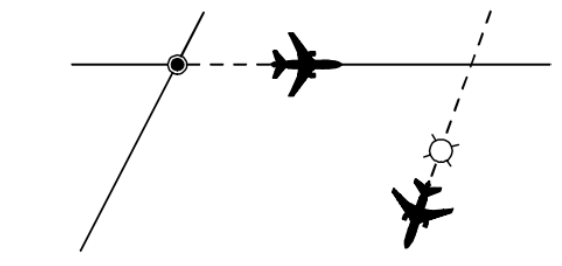
*By use of the same navigation aid or method (by requiring aircraft to fly on specified tracks which are separated by a minimum distance appropriate to the navigation aid or method employed)

Lateral separation between aircraft using different navigation aids, or when one aircraft is using RNAV equipment, shall be established by ensuring that the derived protected airspaces for the navigation aid(s) or RNP do not overlap.
¶ Lateral separation minima
The lateral separation minima by use of the same navigation aid are:
- VOR: both aircraft are established on radials which diverge by at least 15° and at least one aircraft is at a distance of 28km or 15NM or more from the facility

*NDB: both aircraft are established on tracks to or from the NDB which diverge by at least 30° and at least one aircraft is at a distance of 28km or 15NM or more from the facility
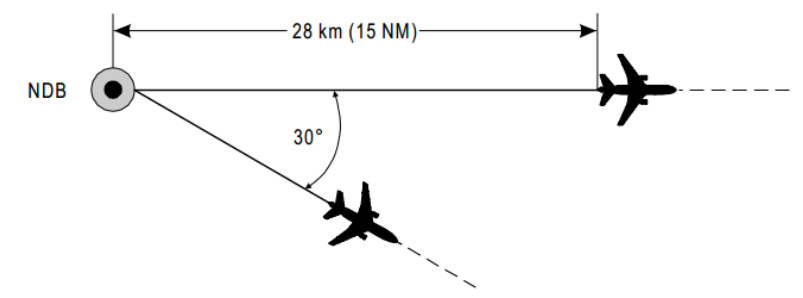
*Dead reckoning: both aircraft are established on tracks which diverge by at least 45° and at least one aircraft is at a distance of 28km or 15NM or more from the point of intersection of the track and both aircraft are established outbound from the intersection.
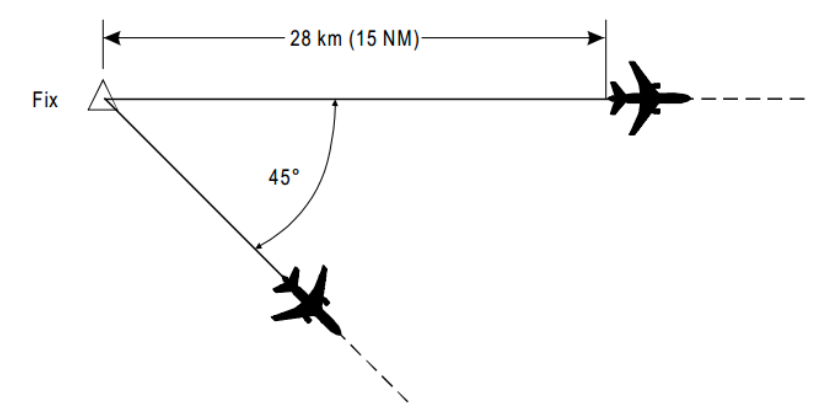
*RNAV operations: both aircraft are established on tracks which diverge by at least 15° and the protected airspace associated with the track of one aircraft does not overlap with the protected airspace associated with the track of the other aircraft.
¶ Lateral separation minima for departures and arrivals
Lateral separation of departing and/or arriving aircraft on published adjacent instrument flight procedures will exist under the following conditions:
- Where the distance between RNAV1, Basic RNP1, RNP APCH and/or RNP AR APCH is not less than 13km or 7NM
- Where the protected areas of tracks designed using obstacle clearance criteria do not overlap and provided operational error is considered.
If the aircraft take the same departure or arrival flight procedure, the separation to apply shall not be lateral separation but longitudinal separation.
¶ Lateral separation of aircraft on parallel or non-intersecting tracks
Lateral separation of aircraft on parallel or non-intersecting tracks or ATS routes shall be established in accordance with the following:
- For a minimum spacing between tracks of 50NM or 93km when using a navigational performance of RNAV10 (RNP10) or RNP4
- For a minimum spacing between tracks of 30NM or 55.5km when using a navigational performance of RNP4
¶ Longitudinal separation general
Longitudinal separation shall be applied so that the spacing between the estimated positions of the aircraft being separated is never less than a prescribed minimum.
Longitudinal separation between aircraft following the same or diverging tracks may be maintained by application of speed control, including Mach number technique.
When aircraft are expected to reach minimum separation, speed control shall be applied to ensure that the required separation minimum is maintained.
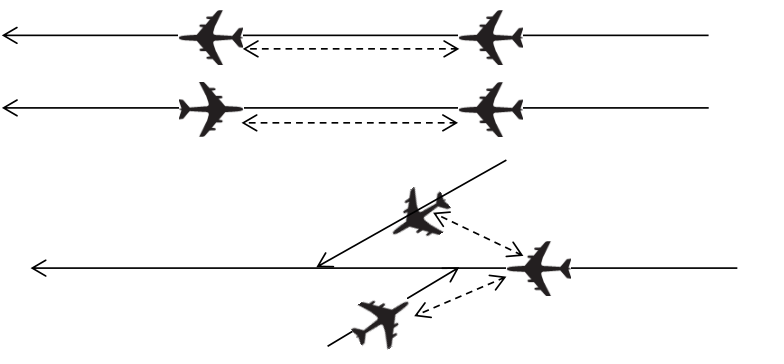
¶ Definition: same, reciprocal and crossing tracks
Same tracks are same direction tracks or intersecting tracks when angular difference of these both tracks is less than 45° or more than 315°
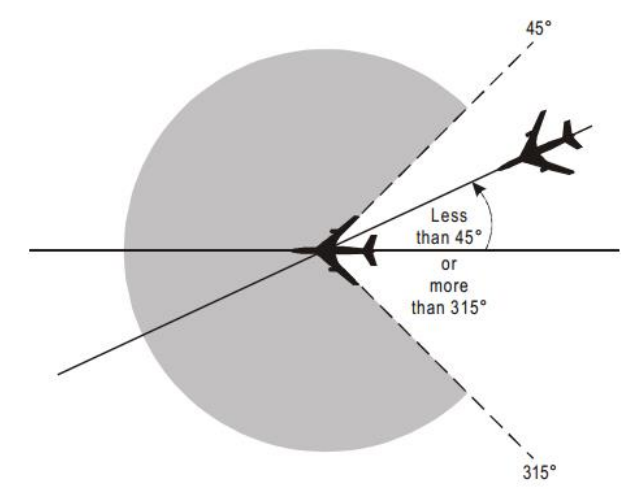
Reciprocal tracks are opposite direction tracks and intersecting tracks when angular difference of these both tracks is more than 135° or less than 225°
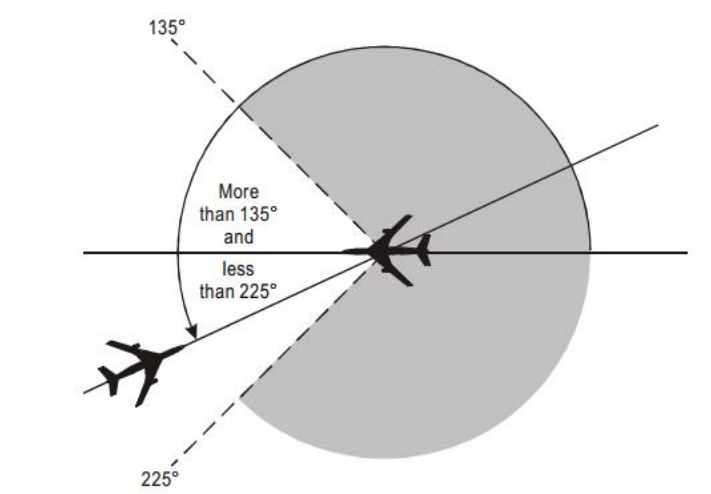
Crossing tracks are intersecting tracks in other conditions than "same track" and "reciprocal track"
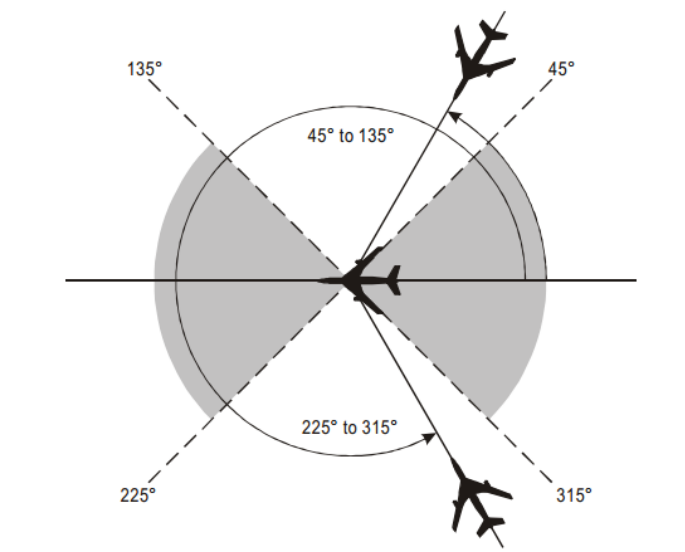
¶ Longitudinal separation minima based on time
¶ Aircraft maintaining same level on same track
| Situation | Default minimum separation | Default minimum separation if navigation aids permit frequent determination of position and speed | Default minimum separation in each case the preceding aircraft is maintaining a true airspeed of 37km/h (20kt) or more faster than the succeeding aircraft | Default minimum separation in each case the preceding aircraft is maintaining a true airspeed of 74km/h (40kt) or more faster than the succeeding aircraft |
| Aircraft on same track | 15 minutes | 10 minutes | 5 minutes | 3 minutes |

¶ Aircraft maintaining same level on crossing track
| Situation | Default minimum separation | Default minimum separation if navigation aids permit frequent determination of position and speed |
| Aircraft on crossing track | 15 minutes | 10 minutes |

¶ Aircraft climbing and descending on same track
| Situation | Default minimum separation | Default minimum separation if navigation aids or GNSS permit frequent determination of position and speed | Default minimum separation if level change is commenced within 10 minutes of the time of second aircraft has reported over common point (derived from ground based radio navigation aids or by GNSS) |
| Aircraft on same track | 15 minutes while vertical separation does not exist | 10 minutes while vertical separation does not exist | 5 minutes while vertical separation does not exist |
Note GNSS=GPS navigation


Both figure above: Default minimum separation
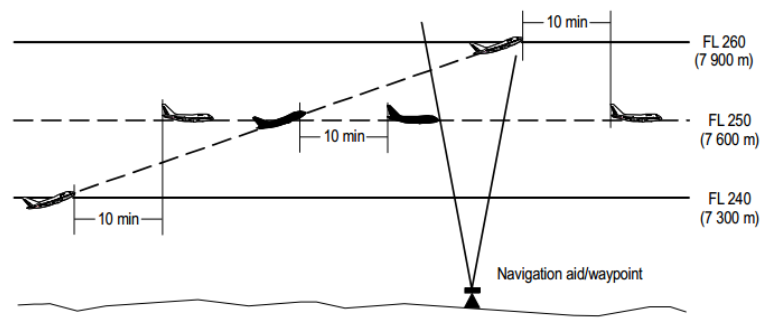
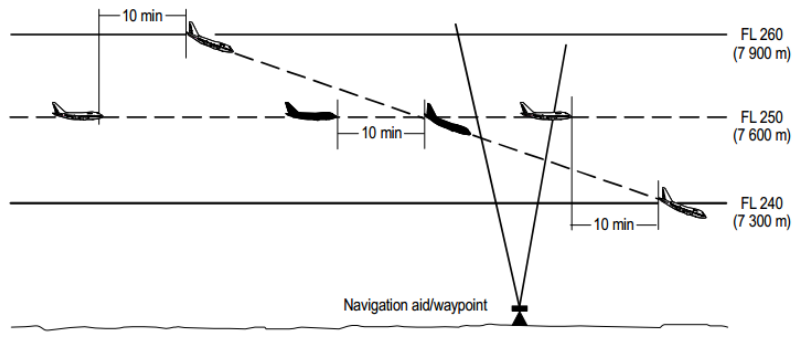
Both figures above: Default minimum separation if navigation aids or GNSS permit frequent determination of position and speed
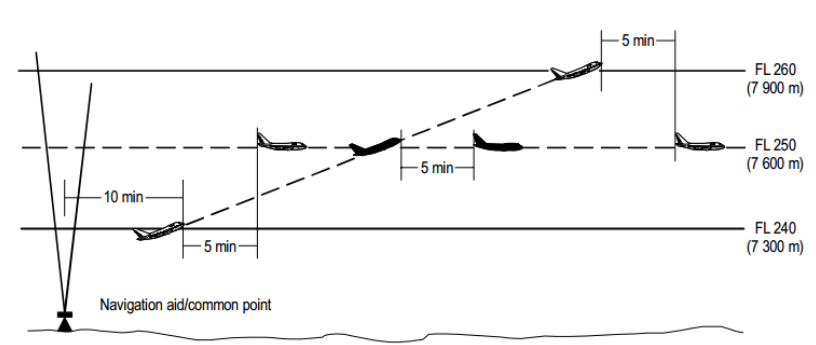
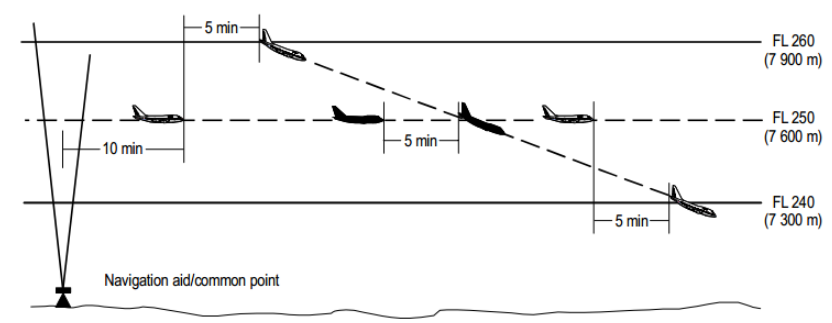
Both figures above: Default minimum separation if level change is commenced within 10 minutes of the time of second aircraft has reported over common point
¶ Aircraft climbing and descending on crossing track
| Situation | Default minimum separation | Default minimum separation if navigation aids permit frequent determination of position and speed |
| Aircraft on crossing track | 15 minutes while vertical separation does not exist | 10 minutes while vertical separation does not exist |
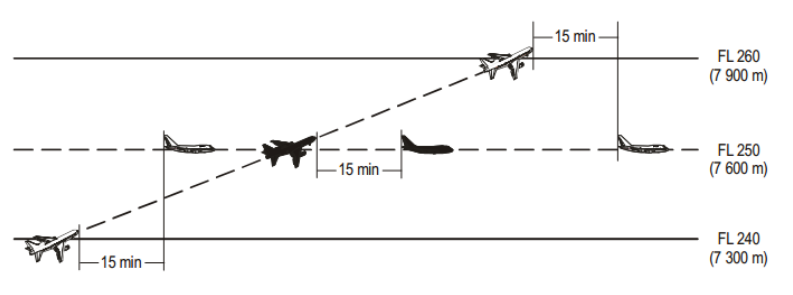
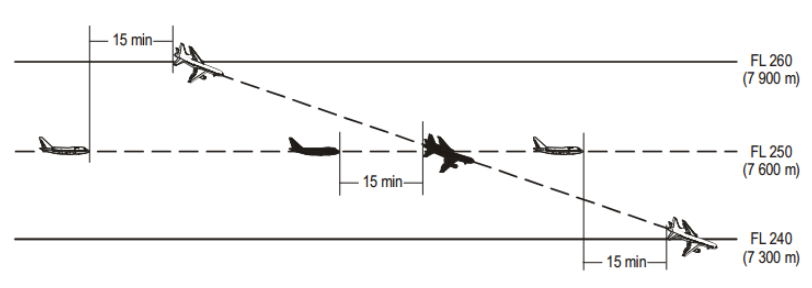
Both figures above: Default minimum separation
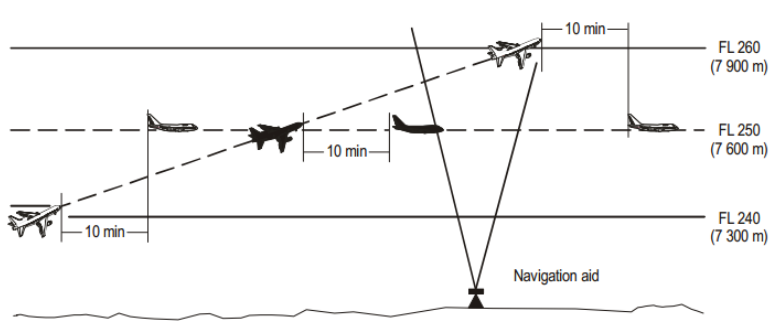
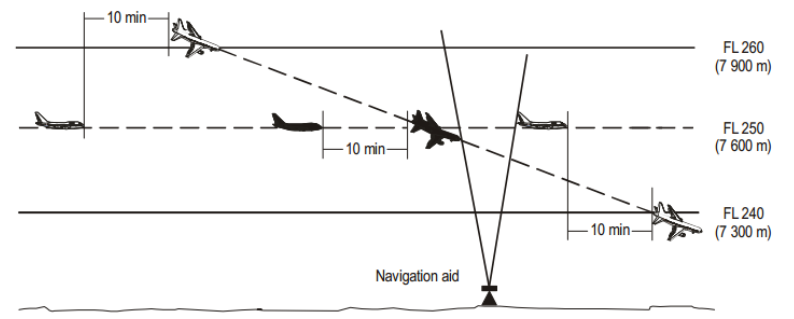
Both figures above: Default minimum separation if navigation aids permit frequent determination of position and speed
¶ Aircraft on reciprocal track
When lateral separation is not provided, vertical separation shall be provided for at least 10 minutes prior to and after the time the aircraft are estimated to pass or are estimated to have passed.
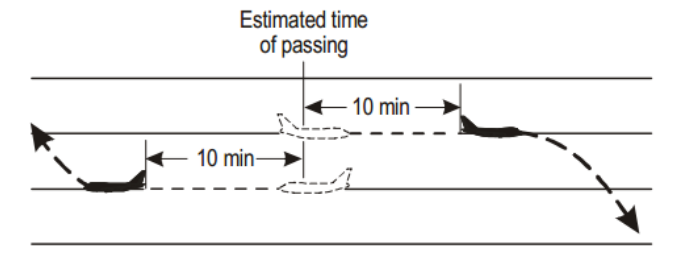
¶ Longitudinal separation minima based on distance using DME and/or GNSS
Separation shall be established by maintaining not less than specified distance between aircraft positions as reported by reference to DME in conjunction with other appropriate navigation aids and/or GNSS (GPS).
This type of separation shall be applied between two aircraft using DME, or two aircraft using GNSS, or one aircraft using DME and one aircraft using GNSS. (This is applicable for all sub-chapters hereunder).
Separation is checked by obtaining simultaneous DME and/or GNSS reading from the aircraft at frequent intervals to ensure that the minimum will not be infringed.
¶ Aircraft maintaining same level on same track
| Situation | Default minimum separation | Default minimum separation in each case the preceding aircraft is maintaining a true airspeed of 37km/h (20kt) or more faster than the succeeding aircraft |
| Aircraft on same track | 20 NM\ 37 km | 10 NM\ 19 km |

¶ Aircraft maintaining same level on crossing track
| Situation | Default minimum separation | Default minimum separation in each case the preceding aircraft is maintaining a true airspeed of 37km/h (20kt) or more faster than the succeeding aircraft |
| Aircraft on crossing track | 20 NM\ 37 km | 10 NM\ 19 km |
This longitudinal separation shall also apply at the crossing point of the tracks and when the relative angle between the tracks is less than 90 degrees.
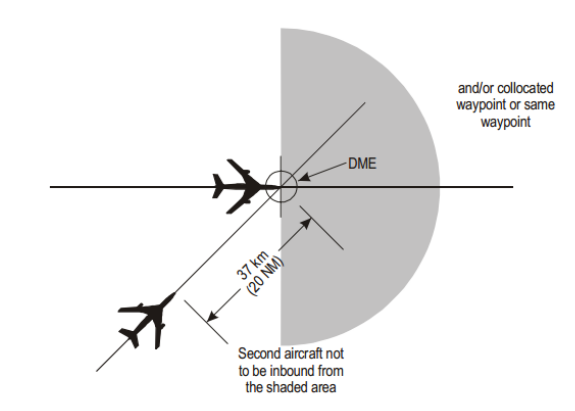
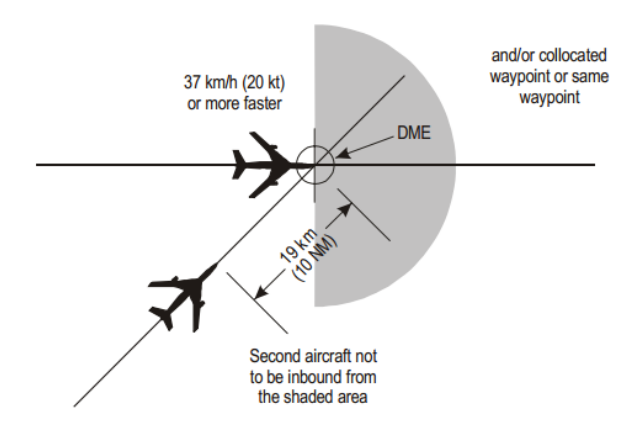
¶ Aircraft climbing and descending on the same track
| Situation | Default minimum separation |
| Aircraft on same track | 19 km or 10 NM while vertical separation does not exist |
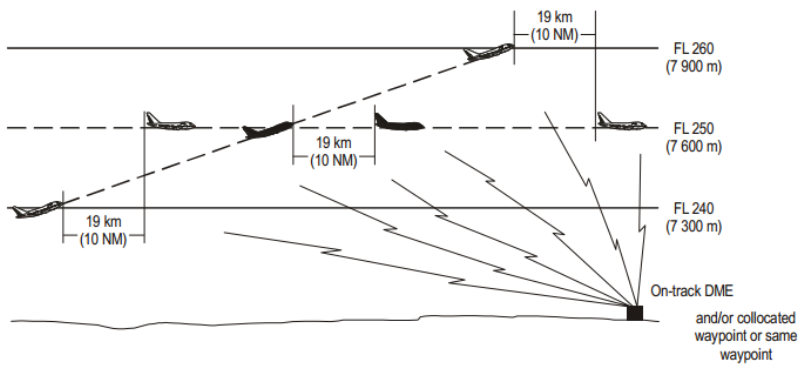
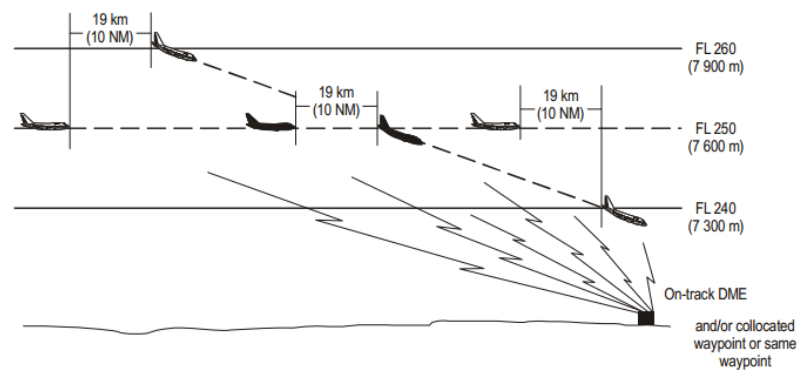
¶ Aircraft on reciprocal tracks
Aircraft may be cleared to climb or descend through the levels occupied by other aircraft when it has been positively established that the aircraft have passed each other and are at least 10 NM apart.
¶ Longitudinal separation minima with Mach number technique based on time
When the Mach number separation technique is applied and when aircraft follow the same track or continuously diverging tracks (until some other form of separation is provided):
- Minimum longitudinal separation between turbojet (whether in level, climbing, descending) is 10 minutes or
- Minimum longitudinal separation between turbojet (whether in level, climbing, descending) is between 5 and 9 minutes depending of speed of preceding aircraft given in the table below.
| Preceding aircraft is maintaining a true Mach number greater than the following aircraft | Minimum longitudinal separation using Mach separation technique |
|---|---|
| Preceding aircraft is Mach 0.02 faster than following aircraft | 9 Minutes |
| Preceding aircraft is Mach 0.03 faster than following aircraft | 8 Minutes |
| Preceding aircraft is Mach 0.04 faster than following aircraft | 7 Minutes |
| Preceding aircraft is Mach 0.05 faster than following aircraft | 6 Minutes |
| Preceding aircraft is Mach 0.06 faster than following aircraft | 5 Minutes |
When the 10 minute longitudinal separation minimum with Mach number technique is applied, the preceding aircraft shall maintain a true Mach number equal to or greater than the following aircraft.
¶ Longitudinal separation minima with Mach number technique based on distance RNAV
An 80NM or 150km RNAV distance-based separation minimum with Mach number technique may be used on the same direction track in preplacement of a 10 minutes longitudinal separation with Mach number technique with:
- Each aircraft reports its distance to or from the same common point located on the track
- Separation between aircraft at the same level is checked by obtaining simultaneous RNAV distance readings from the aircraft at frequent intervals to ensure that the minimum will be not infringed

*Separation between aircraft climbing or descending is checked by obtaining simultaneous RNAV distance readings from the aircraft
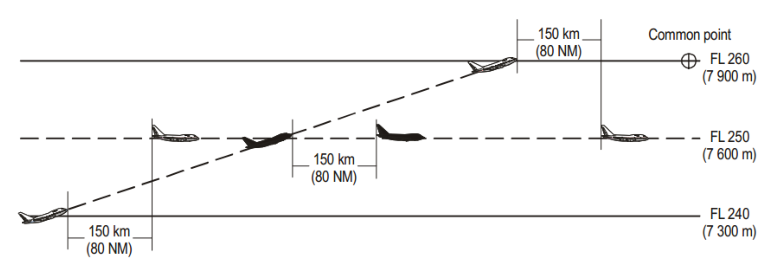
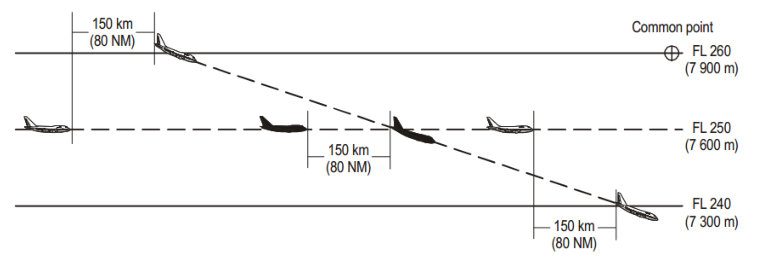
*In the case of one aircraft climbing or descending, one aircraft maintains level while vertical separation does not exist
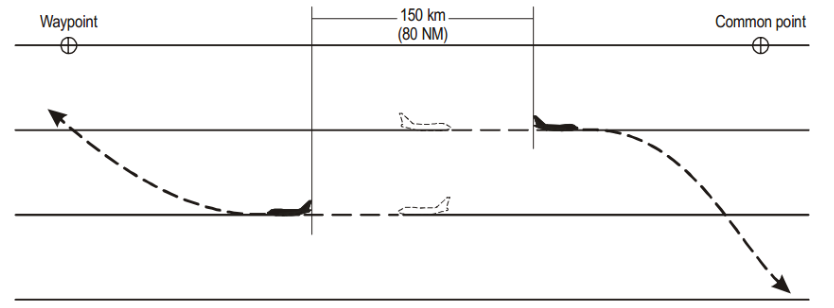
In order to require RNAV distance information, position reports should be referenced to a common point ahead of both aircraft.
RNAV distance based separation minima shall not be applied after ATC has received pilot advice indicating navigation equipment deterioration or failure.
When the 80 NM or 150km RNAV longitudinal separation minimum with Mach number technique is applied, the preceding aircraft shall maintain a true Mach number equal to or greater than the following aircraft.
¶ Longitudinal separation minima based on distance using RNAV where RNP is specified
Direct controller-pilot communication shall be maintained while applying distance-based separation minima. Direct controller-pilot communication shall be voice or CPDLC (text mode).
For aircraft cruising, climbing or descending on the same track, the following separation minimum may be used:
- 50 NM or 93km separation minimum and,
- RNP 10 and,
- Direct controller-pilot communication and,
- Procedural position reports and,
- Verification of position at least every 24 minutes
During application of this separation, when an aircraft fails to report its position, the controller shall take action to establish communication. If communication has not been established within 8 minutes, the controller shall take action to apply an alternative form of separation.
¶ Longitudinal separation minima based on distance using RNP RNAV using ADS-C
This chapter is not applicable for the IVAO network as ADS-C is not implemented in our tools.
Consult ICAO 4444 documentation §5.4.2.6.4.1.
¶ Separation of aircraft holding in flight
Except when lateral separation exits in this area, vertical separation shall be applied between aircraft holding in flight and other aircraft (whether arriving, departing and en-route) whenever the other aircraft concerned are within five minutes flying time of the holding area.
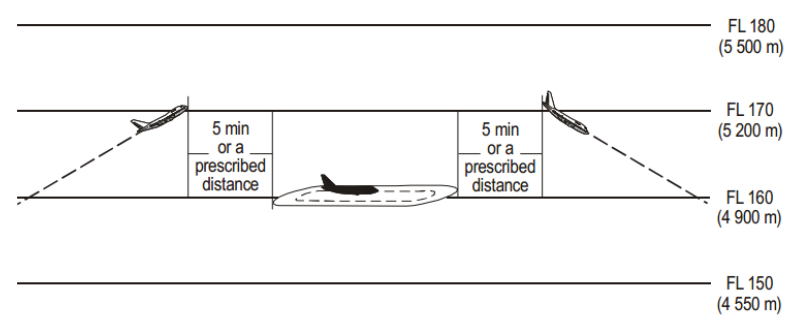
¶ Minimum separation between departing aircraft
The following separations are complementary to the longitudinal separation minima specified in this documentation.
1 minute is required if aircraft are to fly on tracks diverging by at least 45° immediately after take-off.
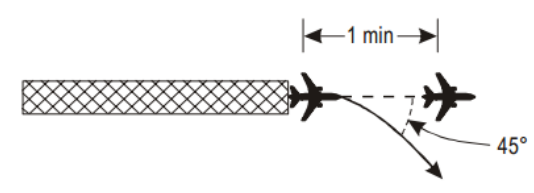
Note that this minimum may be reduced when aircraft are using parallel runways or diverging runways which do not cross approved by local air traffic regulation or parallel runway regulation.

2 minutes are required between take-offs when the preceding aircraft is 40kt or 74km/h (or more) faster than the following aircraft and both aircraft will follow the same track.
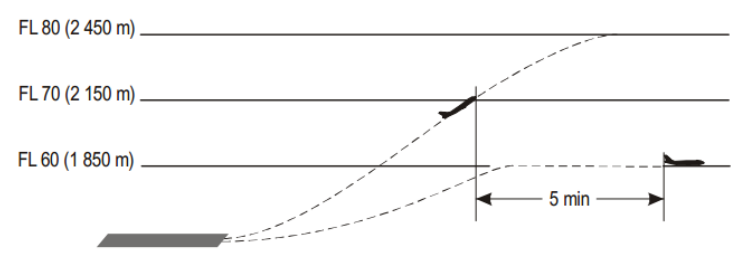
5 minutes separation is required while vertical separation does not exist if a departing aircraft will be flown through the level of a preceding departing aircraft and both aircraft will follow the same track
¶ Separation of departing aircraft from arriving aircraft
The following separation shall be applied when take-off clearance is based on the position of an arriving aircraft:
⠀- If an arriving aircraft is making a complete instrument approach, a departing aircraft may take off:
⠀⠀⠀- In any direction until an arriving aircraft has started its procedure turn or base turn leading to final approach
⠀⠀⠀- In a direction which is different by at least 45° from the reciprocal of the direction of approach after the arriving aircraft has started its procedure turn or base turn leading to final approach, provided that the take-off will be made at least 3 minutes before the arriving aircraft is estimated to be over the beginning of the instrument runway.
⠀- If an arriving aircraft is making a straight-in approach, a departing aircraft may take off :
⠀⠀⠀- In any direction until 5 minutes before the arriving aircraft is estimated to be over the instrument runway
⠀⠀⠀- In a direction which is different by at least 45° from the reciprocal of the direction of approach after the arriving aircraft:
⠀- Until 3 minutes before the arriving aircraft is estimated to be over the beginning of the instrument runway, or *Before the arriving aircraft crosses a designated fix on the approach track. (the location of such fix is determined by air traffic control authority).
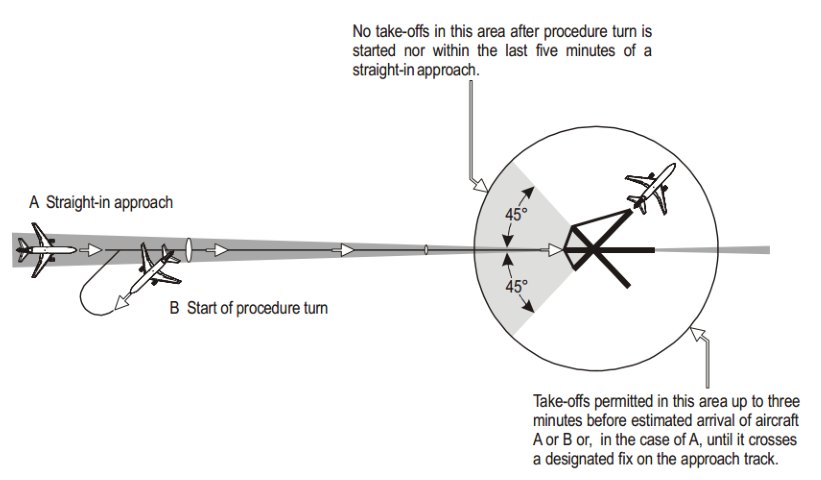
¶ Wake turbulence separation longitudinal separation
Please consult "wake turbulence separation minima" article.
¶ Clearances to fly maintaining own separation while in VMC
The provision of vertical and/or horizontal separation by an air traffic control unit is not applicable in respect of any specified portion of a flight cleared subject to maintaining own separation and remaining in visual meteorological conditions (VMC).
Note that a VFR flight must remain in visual meteorological conditions at all times. Accordingly, the issuance of a clearance to a VFR flight to fly subject to maintaining own separation and remaining in visual meteorological conditions has no other object than to signify that, for the duration of the clearance, separation from other aircraft by air traffic control is not provided.
An air traffic controller may clear a controlled flight, including departing and arriving flight, operating in airspaces classes D and E in visual meteorological conditions (VMC) during the hours of daylight to fly subject to maintaining own separation to one other aircraft and remaining in visual meteorological conditions.
The following conditions shall apply:
- The clearance shall be for a specified portion of the flight at or below 10000ft or 3050m, during
climb or descent and subject to further restriction prescribed by regional air navigation regulation.
- The pilot shall inform ATC before entering instrument meteorological conditions (IMC) and shall
proceed in accordance with the alternative instruction given. An IFR flight shall be provided with alternative instructions.
The objectives of the air traffic control service do not include prevention of collision with terrain. The procedures prescribed in this document do not relieve pilots of their responsibility to ensure that any clearances issued by air traffic control units are safe in this respect.
- ICAO Documentation 4444 - Air Traffic Management - 16th Edition 2016 - Chapter 5
- VID 150259 - Creation
- VID 150259 - Wiki integration
- VID 496402 - Wiki.js integration